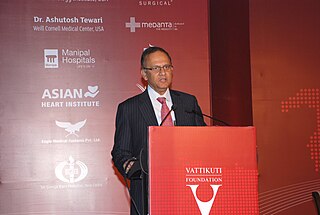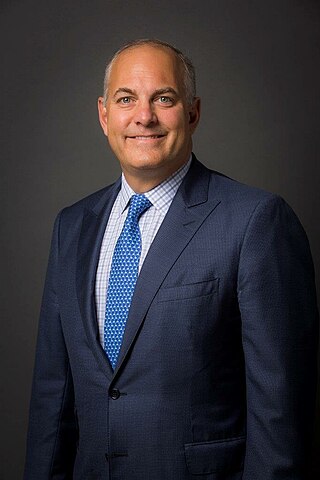Related Research Articles

Urology, also known as genitourinary surgery, is the branch of medicine that focuses on surgical and medical diseases of the urinary-tract system and the reproductive organs. Organs under the domain of urology include the kidneys, adrenal glands, ureters, urinary bladder, urethra, and the male reproductive organs.

Penis enlargement, or male enhancement, is any technique aimed to increase the size of a human penis. Some methods aim to increase total length, others the shaft's girth, and yet others the glans size. Techniques include surgery, supplements, ointments, patches, and physical methods like pumping, jelqing, and traction.
Image-guided surgery (IGS) is any surgical procedure where the surgeon uses tracked surgical instruments in conjunction with preoperative or intraoperative images in order to directly or indirectly guide the procedure. Image guided surgery systems use cameras, ultrasonic, electromagnetic or a combination of fields to capture and relay the patient's anatomy and the surgeon's precise movements in relation to the patient, to computer monitors in the operating room or to augmented reality headsets. This is generally performed in real-time though there may be delays of seconds or minutes depending on the modality and application.

Prostatectomy is the surgical removal of all or part of the prostate gland. This operation is done for benign conditions that cause urinary retention, as well as for prostate cancer and for other cancers of the pelvis.

Robot-assisted surgery or robotic surgery are any types of surgical procedures that are performed using robotic systems. Robotically assisted surgery was developed to try to overcome the limitations of pre-existing minimally-invasive surgical procedures and to enhance the capabilities of surgeons performing open surgery.

Radical retropubic prostatectomy is a surgical procedure in which the prostate gland is removed through an incision in the abdomen. It is most often used to treat individuals who have early prostate cancer. Radical retropubic prostatectomy can be performed under general, spinal, or epidural anesthesia and requires blood transfusion less than one-fifth of the time. Radical retropubic prostatectomy is associated with complications such as urinary incontinence and impotence, but these outcomes are related to a combination of individual patient anatomy, surgical technique, and the experience and skill of the surgeon.

A penile implant is an implanted device intended for the treatment of erectile dysfunction, Peyronie's disease, ischemic priapism, deformity and any traumatic injury of the penis, and for phalloplasty or metoidioplasty, including in gender-affirming surgery. Men also opt for penile implants for aesthetic purposes. Men's satisfaction and sexual function is influenced by discomfort over genital size which leads to seek surgical and non-surgical solutions for penis alteration. Although there are many distinct types of implants, most fall into one of two categories: malleable and inflatable transplants.
Urethroplasty is the surgical repair of an injury or defect within the walls of the urethra. Trauma, iatrogenic injury and infections are the most common causes of urethral injury/defect requiring repair. Urethroplasty is regarded as the gold standard treatment for urethral strictures and offers better outcomes in terms of recurrence rates than dilatations and urethrotomies. It is probably the only useful modality of treatment for long and complex strictures though recurrence rates are higher for this difficult treatment group.
Computer-assisted surgery (CAS) represents a surgical concept and set of methods, that use computer technology for surgical planning, and for guiding or performing surgical interventions. CAS is also known as computer-aided surgery, computer-assisted intervention, image-guided surgery, digital surgery and surgical navigation, but these are terms that are more or less synonymous with CAS. CAS has been a leading factor in the development of robotic surgery.

Mahendra Bhandari is an Indian surgeon who has made substantial contributions to the specialty of urology, medical training, hospital administration, robotic surgery and medical ethics. For his efforts, he was awarded the Padma Shri by the government of India in 2000. Bhandari is currently Senior Bio-scientist and Director of Robotic Surgery Research & Education at the Vattikuti Urology Institute (VUI) in Detroit, MI. He was the Symposium coordinator of the International Robotic Urology Symposium. He also has been the CEO of the Vattikuti Foundation since 2010.

Mani Menon, born 9 July 1948 in Trichur, India, is an American surgeon whose work has helped to lay the foundation for modern Robotic Cancer Surgery. He is the founding director and the Raj and Padma Vattikuti Distinguished Chair of the Vattikuti Urology Institute at the Henry Ford Hospital in Detroit, MI, where he established the first cancer-oriented robotics program in the world. Menon is widely regarded for his role in the development of robotic surgery techniques for the treatment of patients with prostate, kidney, and bladder cancers, as well as for the development of robotic kidney transplantation.
Menon is the recipient of the Gold Cystoscope award, Hugh Hampton Young award, the Keyes Medal, the prestigious B.C. Roy award.

Ashutosh K. Tewari is the chairman of urology at the Icahn School of Medicine at Mount Sinai Hospital in New York City. He is a board certified American urologist, oncologist, and principal investigator. Before moving to the Icahn School of Medicine in 2013, he was the founding director of both the Center for Prostate Cancer at Weill Cornell Medical College and the LeFrak Center for Robotic Surgery at NewYork–Presbyterian Hospital. Dr. Tewari was the Ronald P. Lynch endowed Chair of Urologic Oncology and the hospital's Director of Robotic Prostatectomy, treating patients with prostate, urinary bladder and other urological cancers. He is the current President of the Society for Urologic Robotic Surgeons (SURS) and the Committee Chair of the Prostate Program. Dr. Tewari is a world leading urological surgeon, and has performed over 10,000 robotically assisted procedures using the da Vinci Surgical System. Academically, he is recognized as a world-renowned expert on urologic oncology with over 250 peer reviewed published papers to his credit; he is on such lists as America's Top Doctors, New York Magazine's Best Doctors, and Who's Who in the World. In 2012, he was given the American Urological Association Gold Cystoscope Award for "outstanding contributions to the field of urologic oncology, most notably the treatment of prostate cancer and the development of novel techniques to improve the outcomes of robotic prostatectomy."

John Hartwell Harrison (1909-1984) was an American urologic surgeon, professor, and author. He performed the first human organ removal for transplant to another. This was a pivotal undertaking as a member of the medical team that accomplished the world’s first successful kidney transplant. The team conducted its landmark transplant between identical twins in 1954.

Craig G. Rogers, is an American urologist and the Chair of Urology Vattikuti Urology Institute at the Henry Ford Hospital in Detroit, Michigan. Rogers is known for pioneering minimally invasive robotic kidney surgeries using da Vinci Surgical System including single incision robotic surgeries. He was the first surgeon to utilize ultrasound probe in robotic kidney surgery. On February 9, 2009, he performed the first twittered live robotic surgery.

Michael D. Stifelman Michael D. Stifelman, M.D., is Chair of Urology at Hackensack University Medical Center, Director of Robotic Surgery at Hackensack Meridian Health, and Professor and Inaugural Chair of Urology at Hackensack Meridian School of Medicine.

Raymond A. Costabile is Professor, and Chair Urology with the Department of Urology at the School of Medicine of the University of Virginia. Costabile is a retired Colonel in the US Army and the former Chief of Urology Service at Madigan Army Medical Center. Costabile is an author; his articles on men's reproductive health and infertility have been published in the Journal of Urology and Proceedings in the National Academy of Sciences, among other peer-reviewed scholarly journals. He has also been featured in television interviews in the national media.
Narmada Prasad Gupta is an Indian urologist, medical researcher, writer and the chairman of Academics and Research Division Urology at the Medanta, the Medicity, New Delhi. He is credited with over 10,000 urological surgical procedures and the highest number of urology robotics (URobotic) surgeries in India. He is a former head of the department of urology of the All India Institute of Medical Sciences Delhi and a former president of the Urological Society of India. He received the Dr. B. C. Roy Award, the highest Indian award in the medical category, from the Medical Council of India in 2005. The government of India awarded him the fourth highest civilian honour of the Padma Shri, in 2007, for his contributions to Indian medicine.
Rajveer Purohit is an Indian-born American physician, Director of Reconstructive Urology at the Icahn School of Medicine at Mount Sinai Hospital in New York City, and associate professor in its Department of Urology.

The Urology Foundation (TUF) is a charity that works across the UK and Ireland with the aim of improving the knowledge and skills of surgeons who operate on diseases of the male and female urinary-tract system and the male reproductive organs and funds research to improve outcomes of all urological conditions and urological cancers.
Kamran Ahmed is a Professor and a Urological Surgeon who is affiliated with Sheikh Khalifa Medical City, Abu Dhabi, UAE, Khalifa University, Abu Dhabi and King's College London, United Kingdom.
References
- ↑ Thomas, Daniel (2016). "Dr". International Journal of Surgery (London, England). Elsevier. 36 (Pt A): 25. doi: 10.1016/j.ijsu.2016.10.003 . PMID 27741424.
- 1 2 3 4 Hakky, Tariq; Martinez, Daniel; Lipshultz, Larry; Spiess, Philippe; Carrion, Rafael (2015). "Augmented Reality Assisted Urologic Surgery (ARAUS): A surgical training tool". The Journal of Urology. 193 (4): e271. doi:10.1016/j.juro.2015.02.1254.
- ↑ Scopis Surgical Navigation (23 November 2012). Scopis Augmented Reality: Path guidance to craniopharyngioma. YouTube. Retrieved 16 February 2016.
- 1 2 Dickey, R.M.; Srikishen, N.; Lipshultz, L.I.; et al. (2016). "Augmented reality assisted surgery: A urologic training tool". Asian Journal of Andrology. 18 (5): 732–4. doi: 10.4103/1008-682X.166436 . PMC 5000796 . PMID 26620455.
- 1 2 Peters, Terry (21 May 2015). "Augmented-Reality Assisted Surgery on the Beating Heart". IEEE Toronto. Archived from the original on 16 February 2016. Retrieved 16 February 2016.
- ↑ Bichlmeier, Christoph (8 November 2014). "Interview with Terry Peters – Bringing Research to Clinical Practice". Medical Augmented Reality Blog. Archived from the original on 16 February 2016. Retrieved 16 February 2016.
- ↑ "HoloSurgical completes 1st spine surgery using augmented reality, AI-based navigation system". 10 January 2019.
- ↑ "HoloSurgical announces first surgical procedure utilising ARAI system". 14 January 2019.
- ↑ "Company – Holosurgical Inc". Archived from the original on 2019-08-08. Retrieved 2020-02-27.
- ↑ "Pawel Lewicki".